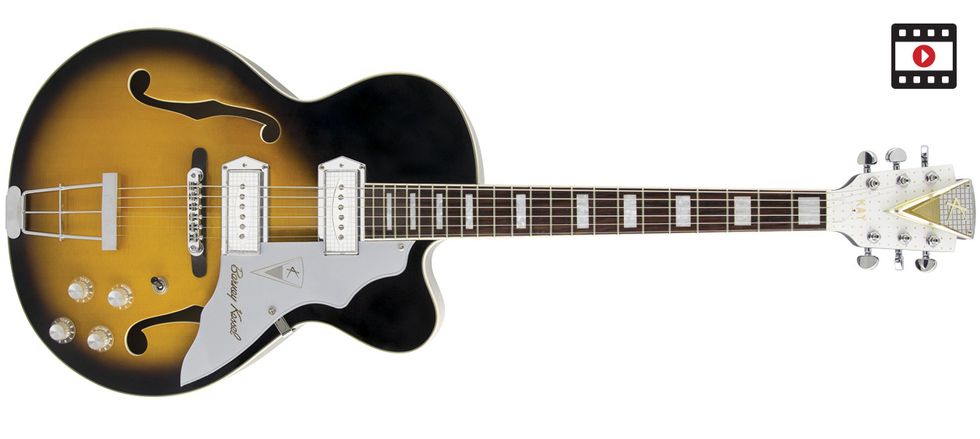Kay Barney Kessel Artist guitar played through a tweed-Deluxe-style 1x12 combo.
0:00 - neck pickup, amp set clean-ish.
0:27 - bridge pickup, amp cranked up for crunch.
RatingsPros:Stylishly retro. High-quality build. Unique sonic personality. Cons: Minor buzzing and fretting-out about halfway up the neck. Some players might like a bridge pickup that cleans up more easily. Street: $1,299 Kay Barney Kessel Artist K6700V kayvintagereissue.com | Tones: Playability: Build/Design: Value: |
Jazz guitarist Barney Kessel had chops to rival just about anyone on the scene back in the 1950s. He was also a first-call session ace who appeared on recordings by the Beach Boys, the Monkees, the Righteous Brothers, Sam Cooke, Elvis Presley, Sonny and Cher, and boatloads of others.
Needless to say, Barney was a big deal. And in 1957, Kay struck an endorsement deal with the guitarist and launched the Barney Kessel line. Over the four years that Barney’s signature Kay models were sold, Kessel mostly stayed loyal to his Gibson ES-350 with Charlie Christian pickups. But the Kessel-branded Kays became coveted as worthy big-brand alternatives and pawn-shop prizes in the intervening decades. Now, a comprehensive reissue of three Kay Barney Kessel models, the Pro K1700V, the Jazz Special K8700V, and the Barney Kessel Artist K6700V—the latter reviewed here—join a roster of resurrected Kays that already includes the very cool Thin Twin and Pro Bass.
K Is for Kelvinator
Even at a distance, it’s easy to see how effectively the China-built Kay captures the visual splendor of the original Barney Kessel Artist. Start playing, though, and it’s also clear that the new Kay company built a better, more playable guitar in many respects. The multi-tiered, three-dimensional plastic “Kelvinator” headstock, named for its resemblance to Kelvinator refrigerator adornments in the ’50s, is a splendid work of mid-20th-century kitsch. It’s also home to a set of efficient 18:1 Grover Rotomatic tuners that make this Kessel a much more stable and modern instrument.
The cosmetic trappings are authentic elsewhere, too. There are clear plastic “Kleenex box” covers on the wide single-coil pickups, a silver-backed plexiglass batwing pickguard with a gold Barney Kessel-signature-and-chevron Kay logo, and a cross-hairs trapeze tailpiece. Laminated woods make up the fully hollowbody construction and the guitar’s pressed arched top is made from two lovely pieces of laminated spruce, replete with tight grain and glowing, flame-like medullary rays that peek through the amber in the vintage sunburst finish. Laminated flame maple makes up the back and sides, and both top and back are trimmed in 4-ply black-and-white celluloid binding. Parallel trestle braces support the top, and the solid, rounded-C-shape Canadian Maple neck is attached with a glued, cantilevered dovetail joint and topped with a bound rosewood 12" radius fretboard with acrylic block inlays. Scale length is 24 3/4". The nut width is 1 11/16".
The distinctive Kleenex box covers hide wide single-coil pickups that measure 12.93k ohms in the bridge and a more tempered 7.65k ohms in the neck. It’s a very “business in the front, party in the back” setup that suggests Kay is equally serious about the Kessel’s capabilities as a jazz and a rock machine. Kay tells us they’re made with ceramic 8 magnets rather than the alnico V of old, and have scatter-wound coils for authentic grit and edge. Controls include a tone and volume for each pickup and a 3-way switch.
Oh-Kay
The neck on the Barney Kessel Artist feels nice, if a bit generic. It’s certainly not unappealing in any way. The guitar arrived with medium action and just a hair of relief in the truss rod. There was just a little buzzing and fretting-out when playing and bending around the 9th to 12th fret region, so a little extra fret leveling might be warranted. That aside, the Kessel feels fun and fast under the fingers, and almost inevitably steers you toward bop and swing chops, even if you’re only a jazz hack at best, like me.
Tested through a tweed-Deluxe-style combo and a Friedman Small Box head and 2x12 cab, the Jekyll & Hyde nature suggested by the pickup selection reveals itself more clearly. In a general sense, the ceramic 8 pickups mix aspects of a P-90 and a Teisco gold-foil, with plenty of their own thing going on. With a clean amp, the neck pickup has a warm, darkish, semi-sweet character that will satisfy jazz dabblers that might want to crank it up with the bridge pickup on the weekends. In that setting, the Barney Kessel Artist transforms into a snarling, gritty, dirt-rock monster that rarely cleans up no matter how quietly you set up your amp. It’s a lot of fun, in a slightly messy way, and, of course, there’s feedback howl aplenty if you get too close to your rig, which is half the fun of using a hollowbody for rowdier rock stuff.
The guitar’s dual nature provides interesting contrasts and a lot of creative potential. But for all the the duality between the neck and bridge pickups, I think this guitar will appeal most to garage rockers, roots and Americana players, and rockabilly guys who can live without a Bigsby.
The Verdict
Kudos are due to the new Kay for bringing back this personality-packed instrument from the golden age of the electric guitar. Our review guitar could have used a little extra attention to the fretwork. And players that prefer relatively balanced output between neck and bridge pickups should be aware that the guitar has a split personality of sorts. Those constraints aside, the Kay’s stylish retro looks, smooth playability, and raw-to-mellow tones make up a package that’s likely to appeal to players across many styles.
Watch the First Look:








![Rig Rundown: Russian Circles’ Mike Sullivan [2025]](https://www.premierguitar.com/media-library/youtube.jpg?id=62303631&width=1245&height=700&quality=70&coordinates=0%2C0%2C0%2C0)

















